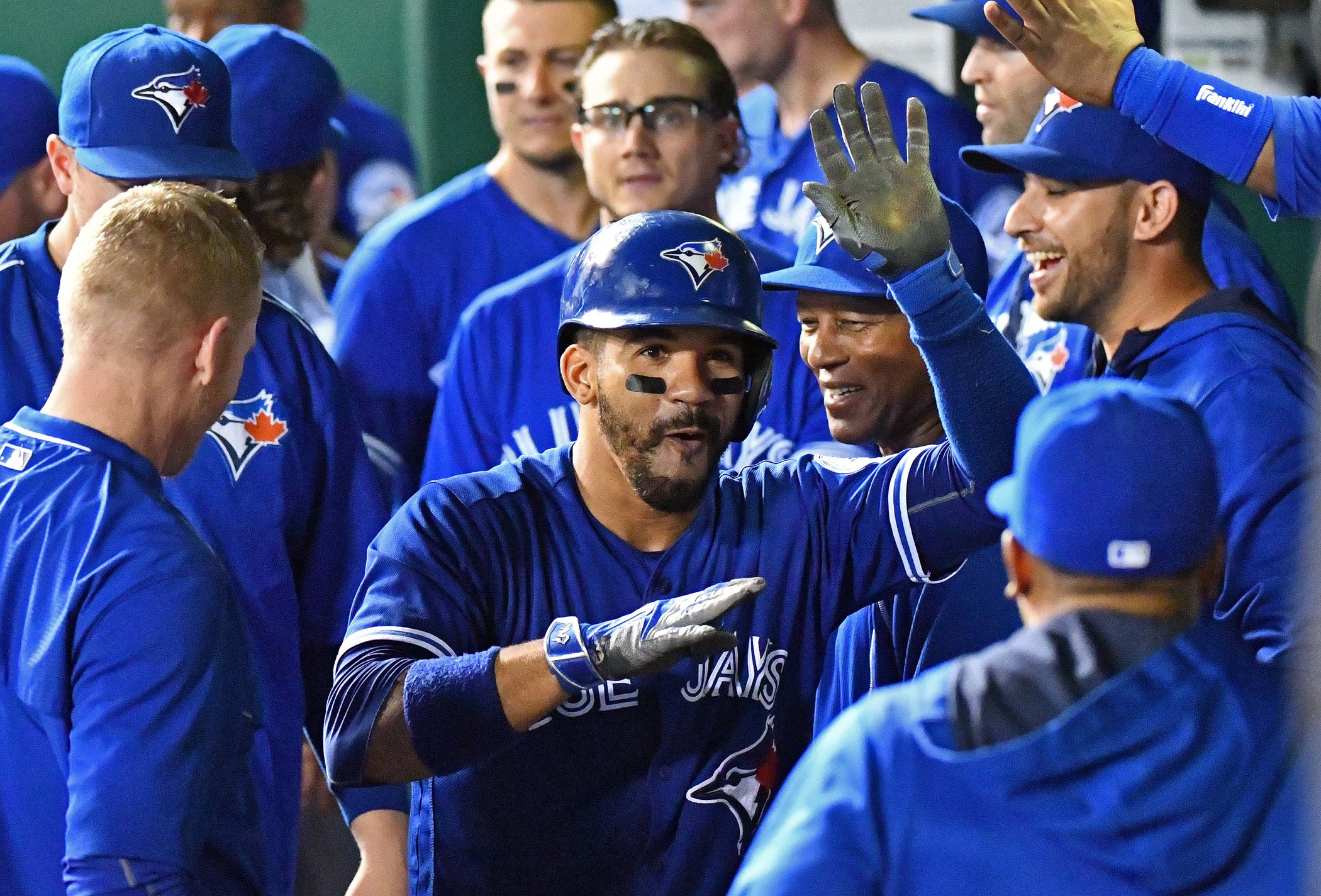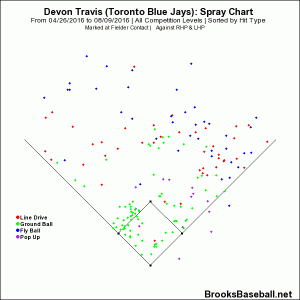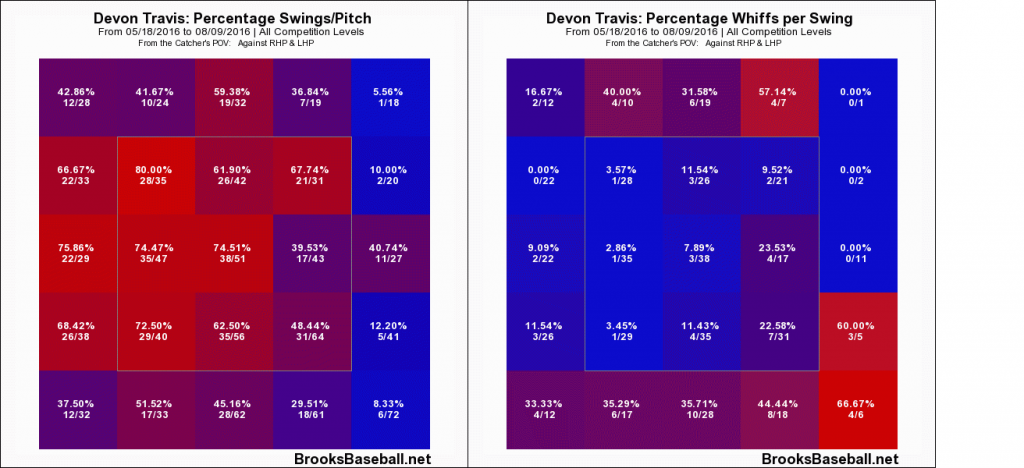When Devon Travis was first acquired in November 2014 for Anthony Gose, the reaction from both the fan base and baseball pundits was rather negative. At the time, Travis was ranked by Baseball America as Detroit’s number one prospect (albeit they were considered to have a relatively weak farm system) and 84th in all of baseball. Several scouting reports had portrayed Travis as simply average.
Thus far in his short career, Devon Travis has done nothing but prove them wrong.
Travis’ career in Toronto got off to a scintillating start. Over the course of just 62 games in 2015, Travis hit .304/.361/.498 with 8 home runs and a .347 BABIP, asserting himself into the early Rookie of the Year conversation. His season was derailed by an shoulder injury that prevented him from playing after July 28th and ultimately resulted in shoulder surgery this past off-season.
His recovery caused him to miss spring training entirely, and after a short stint in minor league rehab games, he was reinstated on May 25th when a quad injury to Troy Tulowitzki necessitated Travis’ early return. Travis understandably got off to a slow start offensively, batting.208/.240/.250, albeit in only six games in May. Since then, however, Devon Travis has been a man on fire. His four hits in Monday’s game against the Tampa Bay Rays were just one of three career milestones he’s reached in under a week: he also hit his first major-league triple in Monday’s game, and on Saturday he had his first multi-home run game. Currently, Travis is batting .303/.341/.500 with a BABIP of .349 on the season; having amassed a 2.1 WARP in just 59 games. He leads the majors with 18 hits in the month of August and is currently riding a seven game hitting streak. Exactly what is driving his success at the plate? There are a number of factors to consider.
A key element to Travis’ offensive prowess has been his plate discipline, which is a difficult thing to have achieved after so little time in the majors. He has a keen eye for pitch location and will fight off pitches until he gets one to hit. He is a contact guy, with just 14 walks in 245 plate appearances (5.7%) this season but his strikeout rate is average (20.4%). Travis swings the bat essentially on average but his contact rate on pitches both outside and inside the zone is above average.
| Stat | Travis | Average |
| O-Swing | 33.6% | 30% |
| Z-Swing | 65.3% | 65% |
| Swing | 48.8% | 46% |
| O-Contact | 71.5% | 66% |
| Z-Contact | 91.6% | 87% |
| Contact | 84.4% | 80% |
| SwStr | 7.6% | 9.5% |
Part of that plate discipline is Travis’ ability to hit the ball the other way, which has become a crucial part of his success. As a skill, this is something that many players either cannot do or learn to do later in their career, while Travis appears to have mastered it early, allowing him to hit pitches on the outside corner as well as those thrown inside.
Right-handed hitters will naturally prefer pitches on the inside of the plate, but his inside-out swing allows him to reach balls on the outside half that he shoots to the opposite field, making him shift-proof. Such an acute awareness of the strike zone affords him plate coverage so that no mater what a pitcher throws, it has to be a great pitch to get him out. He rarely swings at pitches that are well out of the zone, and those that he has whiffed on have simply been good pitches.
Travis’ ability to see the ball well and fight off good pitches is what allows him to have a good two-strike approach. With two strikes against, Travis is hitting .285/.313/.503; major leaguers typically hit around .200 with two strikes.
The one element of Travis’ game that was most undervalued on scouting reports was his power. One scouting report gave his power a future grade of 40, stating he could hit 9 to 12 home runs if his power tool reaches its peak. Thus far this season, Travis has hit 10 home runs in 59 games; extrapolated over an entire season, that equates to 27.5 home runs. In 2015, his 8 home runs in 62 games put him on pace for 20.9 home runs. He has a great swing path, keeping the barrel of the bat in a plane that travels up towards the ball, and is able to turn on the ball quite fast, allowing him to drive the ball. His home runs haven’t been of the cheap variety, either; collectively their true distance averages 401.6 feet.
Although this is a piece meant to highlight Travis’ offensive game, I would be remiss if I failed to touch on his defense, an aspect of his game that Travis himself feels is often overlooked. His 4.7 UZR rating is above average and ranks him sixth amongst second basemen (minimum 500 innings), and his 0.8 FRAA is above average. What he lacks in horizontal range he makes up for in baseball IQ (or what R.A. Dickey referred to as baseball acumen), as evidenced by this nifty heads-up play Monday night:
With only 121 games at the major-league level, some may still wonder if the production we’re seeing from Travis is legit. But, if you look at his numbers throughout his minor-league career (he hit .317/.381/.474 over 277 games), it’s clear that he has always been able to hit. What we’re seeing now is that success now translating at the big-league level. It’s time to stop wondering if he’s hit over a large enough sample size and start recognizing that this is the hitter that Travis has always been.
Lead Photo: Peter G. Aiken-USA TODAY Sports


